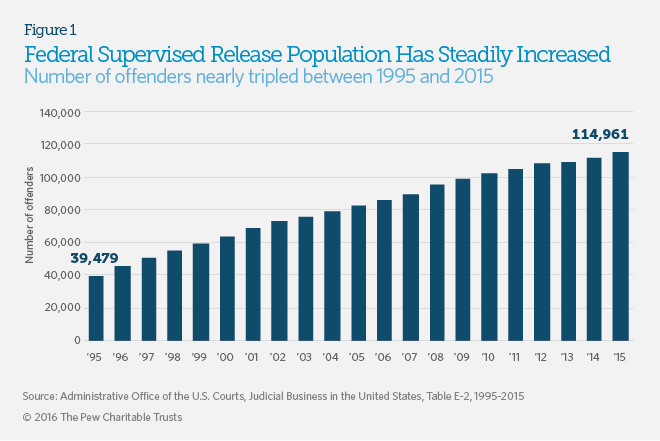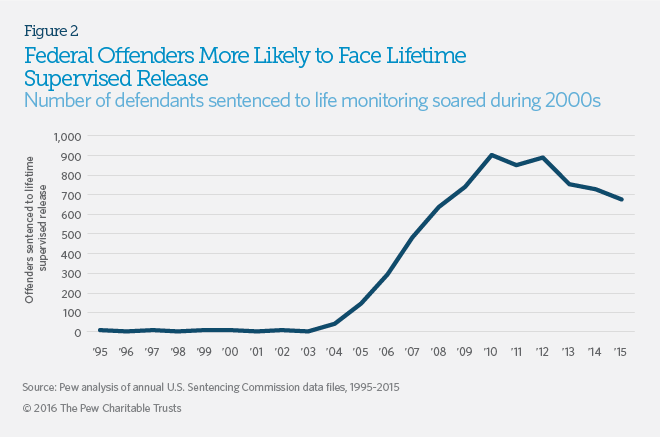http://www.pewtrusts.org/en/research-and-analysis/issue-briefs/2017/01/number-of-offenders-on-federal-supervised-release-hits-all-time-high
With nearly 190,000 inmates, the federal prison system is the largest in the nation, far exceeding those of California, Texas, and other states.1 But the reach of federal corrections extends well beyond prison walls. In 2015, approximately 115,000 offenders were serving a period of post-prison community monitoring known as supervised release—nearly three times as many as in 1995.2 (See Figure 1.) The average time spent under supervision rose 12 percent during that period, to nearly four years.3
Although post-prison monitoring can be an important correctional tool, research shows that policymakers can maximize limited resources and maintain public safety by reducing the length of supervision for certain offenders and prioritizing oversight and services for those most likely to reoffend.4

Nearly all federal inmates face supervised release
More than 8 in 10 offenders sentenced to federal prison also undergo court-ordered supervised release.5 Congress created supervised release in 1984 as a way to help former inmates make the transition back into the community and reduce rates of reoffending.6 Offenders on supervised release are under the jurisdiction of U.S. Probation and Pretrial Services, an agency housed in the judicial branch.7
Supervised release, which went into effect in 1987, replaced parole as the primary system for monitoring federal offenders after prison.8 Although the two programs are similar in some ways, parole serves as a substitute for a portion of incarceration, while supervised release is a separate and additional sentence that begins when imprisonment ends.9 For example, an offender might serve 60 percent of a sentence behind bars and the remaining 40 percent on parole, but an individual on supervised release faces a period of monitoring even after completing a full prison term. Ninety-nine percent of all offenders on federal post-prison supervision in 2015 were on supervised release, with 1 percent still serving time under the old system of parole.10
Larger population, longer terms
The number of federal offenders on supervised release increased every year between 1995 and 2015, rising from approximately 39,000 to nearly 115,000.11 During the same span, the average supervised release sentence went up 12 percent, from 42.1 months to 47.1 months.12 The annual number of offenders sentenced to lifetime supervised release surged from just seven in 1995 to more than 900 in 2010 before declining to 674 in 2015. The rise was especially sharp during the 2000s.13 (See Figure 2.)

Policy changes played a central role in the sharp expansion of supervised release. In particular, the Sentencing Reform Act of 1984, which created the program, also established the U.S. Sentencing Commission, an independent agency within the judicial branch, and tasked it with developing detailed guidelines for federal courts sentencing convicted defendants.14 The commission’s rules required courts to impose supervised release terms in most felony cases.15
Congress separately enacted a variety of laws that require minimum periods of supervised release, in addition to minimum prison terms, for many offenders.16 Drug traffickers, for example, are statutorily subject to supervised release terms of 1 to 10 years, depending on their criminal histories and the types and amounts of drugs involved in their crimes. Offenders convicted of certain sex crimes face lifetime supervision. Kidnapping and domestic violence crimes also are subject to statutory periods of supervised release.
Reducing supervision terms for some offenders can improve outcomes
Post-prison monitoring is an essential feature of any correctional system, but extended periods of community supervision can have negative consequences for offenders and the public. One common result is that more offenders are sent to prison for violating the terms of their supervision (known as technical violations) than for new crimes.
More than two-thirds of all federal offenders who are revoked from supervised release each year committed technical violations but were not convicted of new crimes.17
Research shows that policymakers can safely scale back post-prison monitoring for some offenders to ensure that limited resources are directed toward those most at risk of reoffending. A Sentencing Commission study released in March 2016 found that most rearrests, both for new offenses and technical violations, occur within two years of an inmate re-entering the community.18 The study, which tracked more than 25,000 offenders for eight years, found that nearly 17 percent were arrested within the first year of the follow-up period, compared with less than 2 percent in the eighth year.19 The median time between release and first rearrest was 21 months.20 These data align with a substantial body of existing research showing that supervision resources should be “front-loaded” on offenders who have recently left prison.21
Other studies have shown that shortening supervision terms for compliant offenders does not negatively affect public safety. Federal law gives courts the authority to reduce terms if they find it is “warranted by the conduct of the defendant … and the interest of justice.”22 A 2013 study of that provision by the Administrative Office of the U.S. Courts found that 10.2 percent of offenders who were granted early termination of their supervision in 2008 were rearrested within three years, compared with 19.2 percent of those who completed full terms.23 Recent Pew research also found that a state-level policy in Missouri that allows certain probationers and parolees to shorten their supervision terms by complying with their conditions of release similarly did not result in higher recidivism rates.24
Conclusion
The number of offenders on federal supervised release nearly tripled between 1995 and 2015, reaching an all-time high of approximately 115,000. During the same period, the average length of supervision rose 12 percent, from 42.1 months to 47.1 months. Policy changes made by Congress and the U.S. Sentencing Commission led to the growth in the number of offenders on post-prison monitoring and the increase in their average sentence length. Research shows, however, that policymakers can maximize limited correctional resources and improve public safety by scaling back the length of post-prison monitoring for certain federal offenders and focusing on those who are most likely to return to crime.
Endnotes
- For the number of federal inmates, see Bureau of Prisons, Population Statistics, https://www.bop.gov/about/statistics/population_statistics.jsp (accessed June 2016). For a comparison with states, see Bureau of Justice Statistics, Prisoners in 2014 (September 2015), Table 2, http://www.bjs.gov/content/pub/pdf/p14.pdf.
- Administrative Office of the U.S. Courts, Judicial Business in the United States, Table E-2, 1995-2015, http://www.uscourts.gov/statistics-reports/analysis-reports/judicial-business-united-states-courts. (Data for 1995 and 1996 are not available online.)
- Pew analysis of annual U.S. Sentencing Commission data files, 1995-2015.
- Urban Institute, Putting Public Safety First: 13 Parole Supervision Strategies to Enhance Reentry Outcomes (December 2008), http://www.urban.org/sites/default/files/alfresco/publication-pdfs/411791-Putting-Public-Safety-First--Parole-Supervision-Strategies-to-Enhance-Reentry-Outcomes-Paper-.PDF.
- U.S. Sentencing Commission, Overview of Federal Criminal Cases—Fiscal Year 2014 (August 2015), 4, http://www.ussc.gov/sites/default/files/pdf/research-and-publications/research-publications/2015/FY14_Overview_Federal_Criminal_Cases.pdf.
- Congressional Research Service, Supervised Release (Parole): An Overview of Federal Law (March 2015), 1, https://www.fas.org/sgp/crs/misc/RL31653.pdf.
- United States Courts, “U.S. Probation and Pretrial Services—Supervision,” http://www.uscourts.gov/services-forms/probation-and-pretrial-services/probation-and-pretrial-services-supervision.
- Congressional Research Service, Supervised Release (Parole): An Overview of Federal Law, 1.
- Ibid.
- Administrative Office of the U.S. Courts, Judicial Business in the United States 2015, Table E-2, http://www.uscourts.gov/statistics-reports/judicial-business-2015-tables.
- Administrative Office of the U.S. Courts, Judicial Business in the United States, Table E-2, 1995-2015.
- Pew analysis of annual U.S. Sentencing Commission data files, 1995-2015.
- Ibid.
- Congressional Research Service, Supervised Release (Parole): An Overview of Federal Law, 1.
- Ibid.
- U.S. Sentencing Commission, Federal Offenders Sentenced to Supervised Release (July 2010), 4–6, http://www.ussc.gov/sites/default/files/pdf/training/annual-national-training-seminar/2012/2_Federal_Offenders_Sentenced_to_Supervised_Release.pdf.
- Administrative Office of the U.S. Courts, Judicial Business in the United States 2015, Table E-7A, http://www.uscourts.gov/statistics-reports/judicial-business-2015-tables.
- U.S. Sentencing Commission, Recidivism Among Federal Offenders: A Comprehensive Overview (March 2016), 16, http://www.ussc.gov/ sites/default/files/pdf/research-and-publications/research-publications/2016/recidivism_overview.pdf.
- Ibid.
- Ibid.
- Urban Institute, Putting Public Safety First: 13 Parole Supervision Strategies to Enhance Reentry Outcomes.
- Laura M. Baber and James L. Johnson, “Early Termination of Supervision: No Compromise to Community Safety,” Federal Probation (September 2013): 17, http://www.uscourts.gov/file/fedprob3rdproofssept13082213epdf.
- Baber and Johnson, “Early Termination of Supervision: No Compromise to Community Safety,” 17–22.
- The Pew Charitable Trusts, “Missouri Policy Shortens Probation and Parole Terms, Protects Public Safety” (August 2016), http://www.pewtrusts.org/~/media/assets/2016/08/missouri_policy_shortens_probation_and_parole_terms_protects_public_safety.pdf.
Download Related Materials

